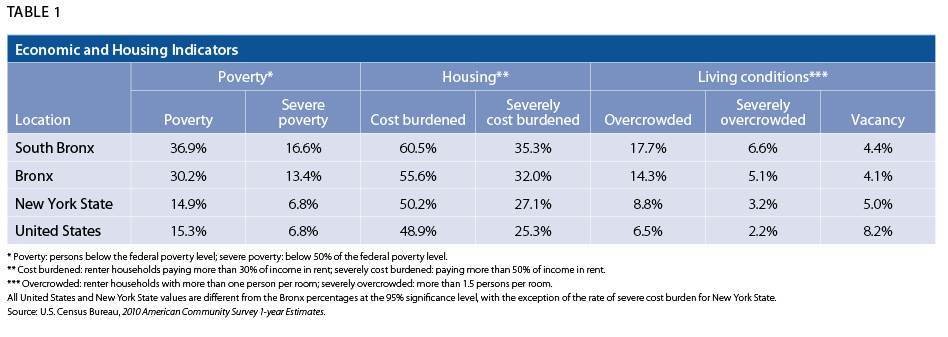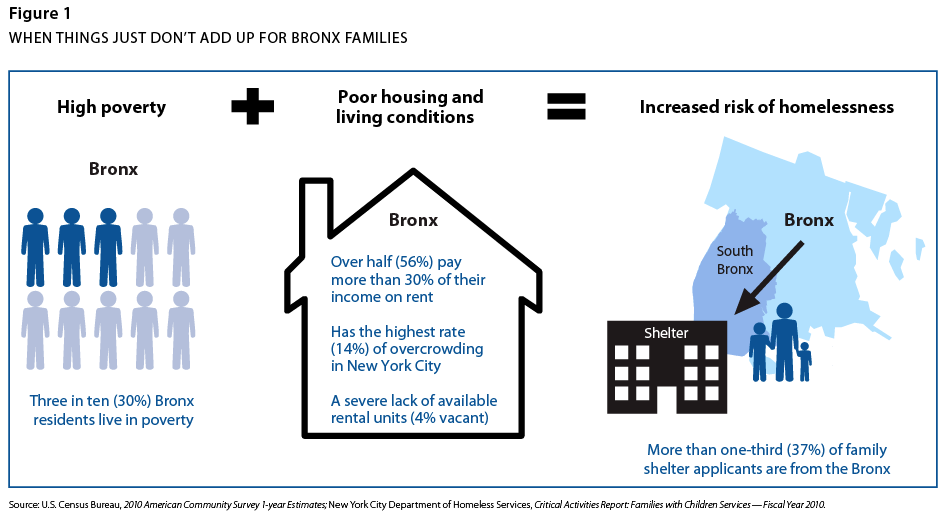a policy brief from ICPH
February 2012
Although the recession officially ended more than a year ago, 2010 saw the largest increase in poverty following an economic downturn in the United States since 1981.1 Nowhere is poverty more apparent today than in the Bronx—specifically the South Bronx. One in three (30.2%) Bronx residents live below the poverty level—less than $18,310 per year for a family of three—and over one in seven (13.4%) experience severe poverty (earning less than 50% of the federal poverty level), both of which are twice the state and national rates (see Table 1). The situation is even more dire in the South Bronx, which constitutes Congressional District 16, the poorest congressional district in the country, where the poverty rate is 36.9% and the severe poverty rate is 16.6%.2 High rates of poverty—combined with overcrowding, rent burdens, and low vacancy levels—push families out of stable housing and into homelessness.

While many Bronx residents live in poverty, black and Hispanic families are most at risk of becoming homeless. More than one-third of Hispanics (35.8%) and nearly one-third (28.3%) of blacks in the Bronx are poor. In 2010, almost all of New York City’s homeless family shelter applicants were either black (52.8%) or Hispanic (40.0%).3
Housing affordability is a challenge even for Bronx families living above the poverty level. More than half (55.6%) of Bronx renters are cost burdened—paying more than 30% of their income on housing expenses—and almost one-third (32.0%) are severely cost burdened, with more than half of their income going towards rental costs (see Figure 1). Both of these rates are higher than the percentage of cost-burdened renters in New York State and nationwide, but lower than they are in the South Bronx, where 60.5% of renters are cost burdened and 35.3% are severely cost burdened.4

Though the cost of housing in the Bronx is high compared to wages, the availability of housing and quality of living conditions is low. The Bronx has the highest rates of overcrowding and severe overcrowding in New York City (14.3% and 5.1%, respectively), which are more than double the percentages of overcrowded (more than one person per room) and severely overcrowded units (more than 1.5 people per room) nationwide (see Table 1). In the South Bronx, nearly one in five (17.7%) households are overcrowded and 6.6% of occupants reside in a unit with severe overcrowding. One cause of overcrowding in the Bronx and South Bronx is the shortage of available apartments; only 4% of rental housing in the Bronx is vacant, half the national rate.5
Economic instability and housing challenges are a problem across the country, but in the Bronx and the South Bronx in particular, these disparities exist at crisis levels, pushing an unacceptable number of families into homelessness (see Figure 1). The combination of low incomes and low-income housing vacancy rates makes it impossible for many families to find affordable apartments, leaving them in overcrowded, stressful living environments. For many of these families—most of who are black or Hispanic—turning to shelter becomes the only option. In 2010, over one-third (37.0%) of all applicants for New York City’s family shelter system were from the Bronx.6 South Bronx families experience homelessness at a rate that is three times higher than it is in New York City as a whole and six times greater than the national level.7 The recession may have ended more than a year ago for the country, but it continues for black and Hispanic families in the South Bronx who are living in shelter, and for those who may be forced into shelter as poverty rates and housing challenges continue to grow. For the time being, the Bronx is, and in all probability will remain, the doorway to homelessness in New York City.